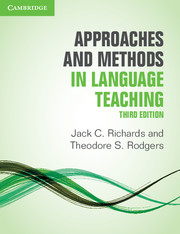Book contents
- Frontmatter
- Contents
- Acknowledgments
- Introduction to the third edition
- I Major trends in twentieth-century language teaching
- II Current approaches and methods
- III Alternative twentieth-century approaches and methods
- IV The teaching and learning environment
- Appendix: Comparison of approaches and methods
- Author index
- Subject index
21 - Approaches, methods, and the curriculum
Published online by Cambridge University Press: 08 April 2022
- Frontmatter
- Contents
- Acknowledgments
- Introduction to the third edition
- I Major trends in twentieth-century language teaching
- II Current approaches and methods
- III Alternative twentieth-century approaches and methods
- IV The teaching and learning environment
- Appendix: Comparison of approaches and methods
- Author index
- Subject index
Summary
Introduction
In describing language teaching approaches and methods in this book, we have focused on the classroom processes that constitute different instructional designs in language teaching and the theories and principles that they are based on. We have seen that approaches and methods reflect different assumptions about what is learned, how it is learned, and what the outcomes of learning are. In educational planning, issues related to the inputs to teaching, to teaching processes, and to the learning outputs that result are elements of the process of curriculum development. The term curriculum refers to the overall plan or design for a course and how the content for a course is transformed into a blueprint for teaching and learning which enables the desired learning outcomes to be achieved.
Curriculum takes content (from external standards and local goals) and shapes it into a plan for how to conduct effective teaching and learning. It is thus more than a list of topics and lists of key facts and skills (the “input”). It is a map of how to achieve the “outputs” of desired student performance, in which appropriate learning activities and assessments are suggested to make it more likely that students achieve the desired results.
(Wiggins and McTighe 2006: 6)In this chapter, we will examine how the approaches and methods we have examined reflect different understandings of how the elements of a curriculum are related and the processes by which they are arrived at. We will consider three alternative strategies that are reflected in the approaches and methods we have described in this book. As we noted in Chapter 8, one strategy is to first make decisions about what to teach (input), then to determine how to teach it (process), and finally to assess what was learned (output). We refer to this as forward design. Another strategy is to start with teaching processes or methodology and to let these determine input and output. We refer to this as central design. A third strategy is to start with learning outcomes or output and work backward to determine issues of process and content. This is known as backward design (Wiggins and McTighe 2006).
Information
- Type
- Chapter
- Information
- Approaches and Methods in Language Teaching , pp. 363 - 381Publisher: Cambridge University PressPrint publication year: 2014
